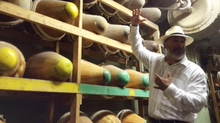Circular Economy - Part 1
In October 2019, the SVA hosted a visit from Nik Engineer (Executive Lead-North America (Interim)/Executive Lead-Business) of the Ellen MacArthur Foundation (EMF). This meeting resulted from outreach on the topic of circular economy efforts in Europe and how it could apply to manufacturing in the U.S.
Three years after its adoption by the European Commission, the 2015 Circular Economy Plan can be considered fully implemented. Clearly Europe is leading the way toward a climate-neutral competitive circular economy, creating investments, jobs and new businesses. In fact, sectors relevant to the circular economy employed more than 4 million workers, a 6% increase compared to 2012. New business opportunities in recycling/repair/reuse have benefitted the environment and the economy. One of the keys to EU’s success are quantified, legally binding objectives.

The SVA and EMF are working on a joint programming opportunity to consider how SMEs might benefit from a broader understanding of the Circular Economy and whether the state can provide incentives and technical assistance. We are also working with education, policy, and community partners to bring together policy research options for cities and states.
WHAT IS A CIRCULAR ECONOMY
A circular economy is an alternative to a traditional linear economy (make, use, dispose) in which we keep resources in use for as long as possible, extract the maximum value from them whilst in use, then recover and regenerate products and materials at the end of each service life.
Underpinned by a transition to renewable energy sources, the circular model builds economic, natural, and social capital. It is based on three principles:
Design out waste and pollution
Keep products and materials in use
Regenerate natural systems
That is, the circular economy promotes the use of as many biodegradable materials as possible in the manufacture of products -biological nutrients- so they can get back to nature without causing environmental damage at the end of their useful life. When it is not possible to use eco-friendly materials -technical nutrients: electronics, hardware, batteries...the aim is to facilitate a simple uncoupling to give them a new life by reintroducing them into the production cycle and compose a new piece. When this is not possible, it will be recycled in a respectful way with the environment.
Power of the inner circle -the tighter the circle-the less requirement of change in reuse, refurbishment and re-manufacturing - higher and potential savings on material, labor, energy and capital along with reduction of external costs, greenhouse gases, water and land toxicity
Power of circling longer- maximization of number and/ or time of consecutive cycles optimized by the design of the product
Power of cascaded use-diversifying the reuse across the value chain reducing the need for an inflow of virgin materials (cotton clothing-second hand apparel-fiber fill in upholstery-insulation)
Power of Pure Circles- uncontaminated material stream maintains quality and efficient collection and redistribution resulting in product longevity and increased material productivity (technical materials)
In order for companies to gain actual cost savings companies must increase the rate products are collected and reused or recuperated. The industry segment with the highest circular economy potential is complex medium lived products. These products include machinery and equipment; office machinery and computers; electrical machinery and apparatus; radio, television, and communication equipment and apparatus; medical, precision and optical instruments, watches and clocks; motor vehicles, trailers, and semi-trailers; other transport equipment; and furniture and other manufactured goods. Short lived products and consumables, such as food and other agricultural products (biological nutrients) can play a restorative role in the circular economy.
STAY TUNED FOR PART 2 OF THE CIRCULAR ECONOMY & SEWN





















